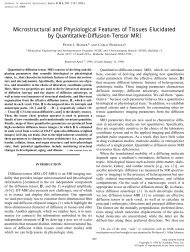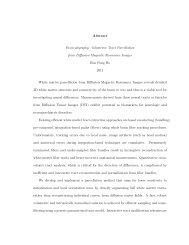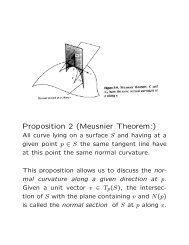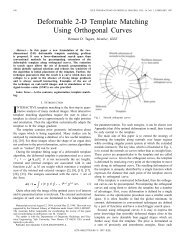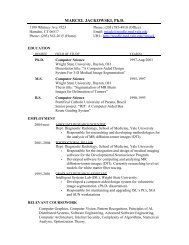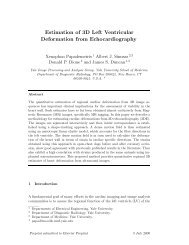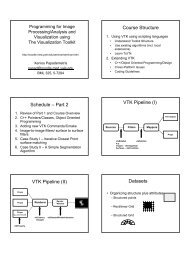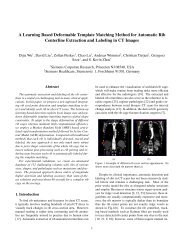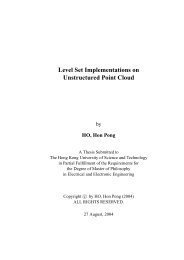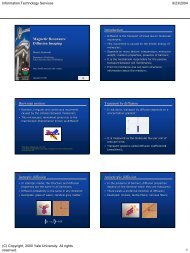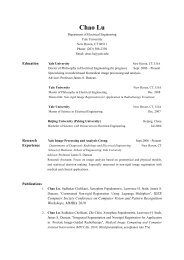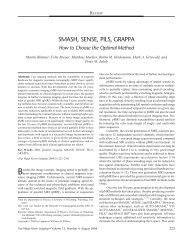Pulsed-field gradient nuclear magnetic resonance as a tool for ...
Pulsed-field gradient nuclear magnetic resonance as a tool for ...
Pulsed-field gradient nuclear magnetic resonance as a tool for ...
You also want an ePaper? Increase the reach of your titles
YUMPU automatically turns print PDFs into web optimized ePapers that Google loves.
216<br />
PRICE<br />
Figure 13 An example of a temperature calibration plot <strong>for</strong> a 5-mm multi<strong>nuclear</strong> inverse<br />
probe <strong>for</strong> a Ž standard bore. Bruker DRX 300 Spectrometer. Generally, the set and actual<br />
temperatures correspond well around ambient temperature using methanol Ž closed squares.<br />
and ethylene glycol Ž closed circles . . Note the kink between the temperature me<strong>as</strong>ured with<br />
methanol and ethylene glycol. This results from imperfect calibration of the chemical shifts<br />
of these compounds with respect to temperature. The solid line represents the ideal c<strong>as</strong>e of<br />
perfect correspondence between the set and actual temperature. The correlation between<br />
the two temperatures can be improved by incre<strong>as</strong>ing the flow rate of the coolingheating<br />
g<strong>as</strong> and moving the thermocouple closer to the sample Ž see, <strong>for</strong> example, Fig. 4 . . However,<br />
shimming generally becomes more problematic <strong>as</strong> the thermocouple becomes closer to the<br />
sample.<br />
Ž .<br />
ents 65 . The thermal <strong>gradient</strong>, T, can be estimated<br />
directly from the linewidth,<br />
linewidth Ž ppm.<br />
Ž 1<br />
T Kcm . 24 1.45 rf coil height Ž cm.<br />
The most fundamental means <strong>for</strong> minimizing<br />
convection problems is to have good temperature<br />
control, which to some extent is generally improved<br />
by incre<strong>as</strong>ing the airflow, although this<br />
will depend strongly on the probe construction<br />
Že.g., the separation between the outside of the<br />
sample and the insert gl<strong>as</strong>s in the probe . . Convection<br />
is also reduced through the use of short and<br />
narrow samples, since the walls retard the onset<br />
of convective flow. If convection is still a problem,<br />
modified PFG diffusion sequences which rely<br />
upon <strong>gradient</strong> moment nulling Ž 64. can be used.<br />
To see how this method works, it is necessary to<br />
understand the connection between flow and<br />
ph<strong>as</strong>e. The ph<strong>as</strong>e shift at time t of a <strong>nuclear</strong> spin<br />
following a path rŽ t. in a <strong>gradient</strong> gŽ t. is given<br />
by<br />
t<br />
H<br />
0<br />
Ž t. gŽ t. rŽ t. dt 25 Only the component of the spin’s motion in the<br />
direction of the <strong>gradient</strong>, zt, Ž. is relevant, and<br />
this can be expanded in a Taylor series Ž 66.<br />
ž / ž /<br />
z 1 2 z<br />
Ž .<br />
2<br />
z t z0 t t <br />
2<br />
t 2 t<br />
t0 t0<br />
<br />
26<br />
<br />
The terms on the right-hand side of Eq. 26<br />
correspond to the position z , velocity <br />
0 0<br />
Ž . Ž 2 2 zt and acceleration a zt .<br />
t0 0 t0,<br />
etc., and thus, Eq. 25 can be rewritten <strong>as</strong><br />
1<br />
Ž t. z M M a M 27 0 0 0 1 0 2<br />
2<br />
where<br />
H<br />
t n<br />
n<br />
0<br />
z<br />
M g Ž t.Ž t. dt 28 M is termed the nth moment of g Ž.<br />
n z t with<br />
respect to t Žn.b.,<br />
this should not be confused<br />
with macroscopic magnetization . . Equation 27 provides the b<strong>as</strong>is of so-called <strong>gradient</strong> moment



